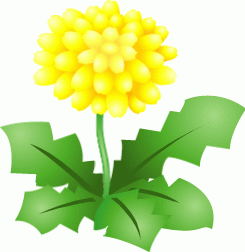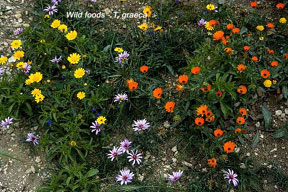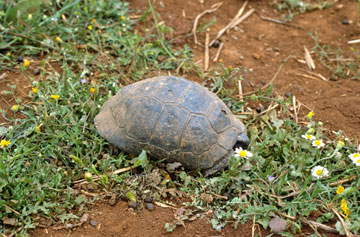
Recommended Foods for Herbivorous Tortoises

It is strongly advised that these plants form the basis of a high fiber staple diet for herbivorous tortoises. In all cases, we recommend the regular addition of a quality multi-mineral and vitamin supplement which includes trace elements such as zinc and selenium. It cannot be emphasized too strongly that requirements will vary from one species to another. In general, those animals which are found in drier areas such as around the Mediterranean tend to have a lower need for trace elements because they have adapted to the shortage of such elements in their native habitats.
ALL
TORTOISES
WILL REQUIRE A HIGH QUALITY
PHOSPHORUS-FREE CALCIUM SUPPLEMENT.
You can read more about this topic HERE.
If you are able to grow a selection of these plants yourself, you should consider the soil type in your garden. The soil type has a major impact upon the availability of minerals and hence on the composition of plants grown upon it. On acid soils, small annual applications of a mineral dressing such as calcified seaweed, which can supply calcium, magnesium and trace elements to the pasture, will help to ensure that animals receive adequate intakes. If you apply the dressing to only part of your plot, you will be able to see whether your animals choose to crop the treated or untreated areas.If, on the other hand, your soils are already lime (calcium) rich, then a seaweed meal dressing will help to boost the trace element content of these soils which tend to be deficient.

Be careful to avoid picking plants from areas contaminated by lead (from vehicle exhausts) or from areas which may have been subjected to chemical spraying.
Recommended basic food plants:- Dandelion (Taraxacum officianale)
- Hawkbits (Leontodon spp.)
- Sowthistles (Sonchus spp.)
- Hawkweeds (Pictis spp.)
- Hawkbeards (Crepis spp.)
- Plantains (Plantago spp.)
- Clovers (Trifolium spp.)
- Honeysuckle (Lonicera periclymenum) [preferred by T. hermanni]
- Cat's ears (Hypochoeris spp.)
- Vetches (Vicina spp.)
- Trefoils (Lotus spp.)
- Mallows (Malva spp.)
- Bindweeds (Calystegia spp.)
- Sedums (Sedum spp.)
- Ivy-leaved Toadflax (Cymbalaria muralis)
- Also (observed eaten by T. hermanni and T. marginata in Greece):
- Robinia (pseudo-acacia) leaves
- Wild clematis
- Acanthus
- Nettles
In practice, the important thing is to provide a variety of fresh 'natural' graze. This is vastly superior to 'supermarket salads' and will supply a far greater range of minerals and essential trace elements. The fiber content will also be far high than 'commercial' salads. If you can manage to grow some of these plants in your tortoise enclosure your tortoises will certainly appreciate your efforts. Not only Mediterranean tortoises will benefit from a healthier diet. Ashley Woods, a Tortoise Trust member who keeps and breeds leopard tortoises (Geochelone pardalis), includes several wild plants in their daily die:
"This is a summary of a diet regime adopted by myself for a breeding colony of Geochelone pardalis babcocki held in my collection, it is also used with success for other species including all Testudo species and Geochelone sulcata (African spurred tortoise). Many suggested captive diets are all too low in one factor - fiber. Leopard tortoises must have a high fiber intake. During spring, summer and early Autumn all my tortoises are fed a diet of 85% wild greens and flowers, commercial greens and fruits are offered as a treat, usually on a once weekly basis. Wild food is not only high in fiber but also has the correct calcium/phosphorus ratio. When collecting wild foods take care of pesticides, try to be familiar with your local area and have 'safe' places for collecting. Also try to leave the roots intact so the plant can recover and grow again.
A list of
wild food offered:
- Dandelion (Taraxacum officinale) leaves, stems and flowers.
- Red clover (Trifolium pratence) leaves, stems & flowers
- White clover (Trifolium repens) leaves, stems and flowers.
- Greater Plantain (Plantago media)
- Ribgrass or Ribwart Plantian (Plantago lancealata)
- Smooth Sow Thistle (Sonchus oleraceus) leaves, stems & flowers
- Prickly Sow Thistle (Sonchus asper) coarsely or finely chopped.
- White-Dead Nettle * (Lamilim album)
- Red-Dead Nettle (Lamium pupureum)
- Chickweed * (Stelaria media)
- Smooth hawks-beard (Crepis capilloris) leaves & flower
- Hedge mustard (Sisymbrium offlcinale) young plants
- Bramble (Rubus fruticosus) shoots, tender leaves & fruit.
Weeds marked * flower and grow throughout the year and can be collected during winter (except in very cold frosty spells) making them a useful addition to winter diets. Obtain a wild plant book and cross reference Latin to common names as some common names may differ regionally.

A wild Testudo ibera grazes in Turkey
Lin King has an excellent free DOWNLOADABLE FEEDING GUIDE on her website. This is full of good ideas on how to find wild foods for your tortoise.
(c) A. C. Highfield/Tortoise Trust 2004